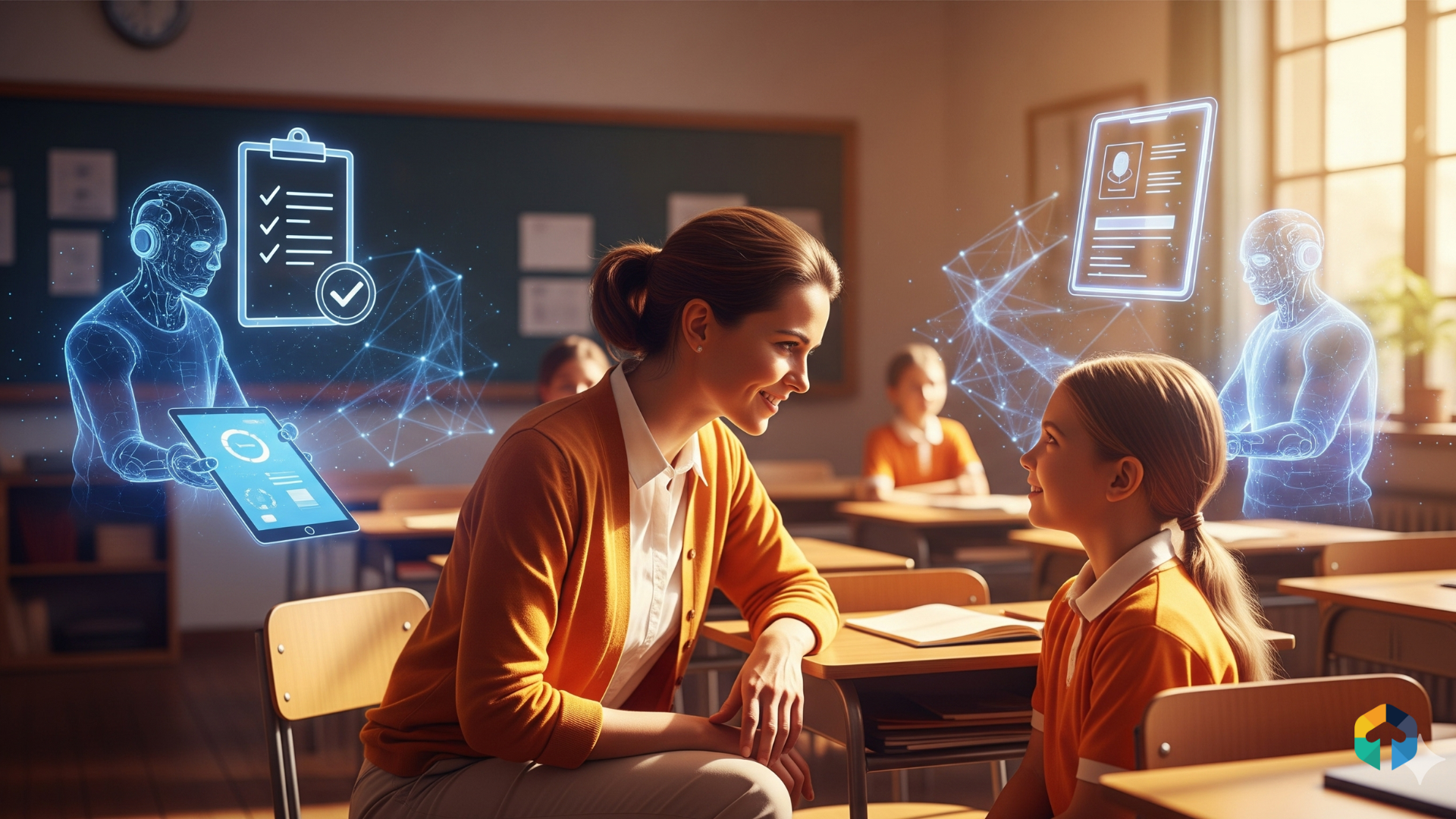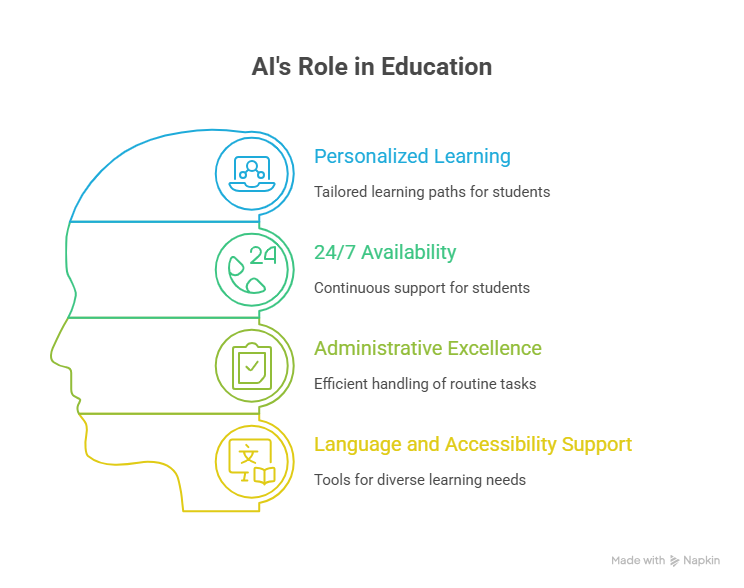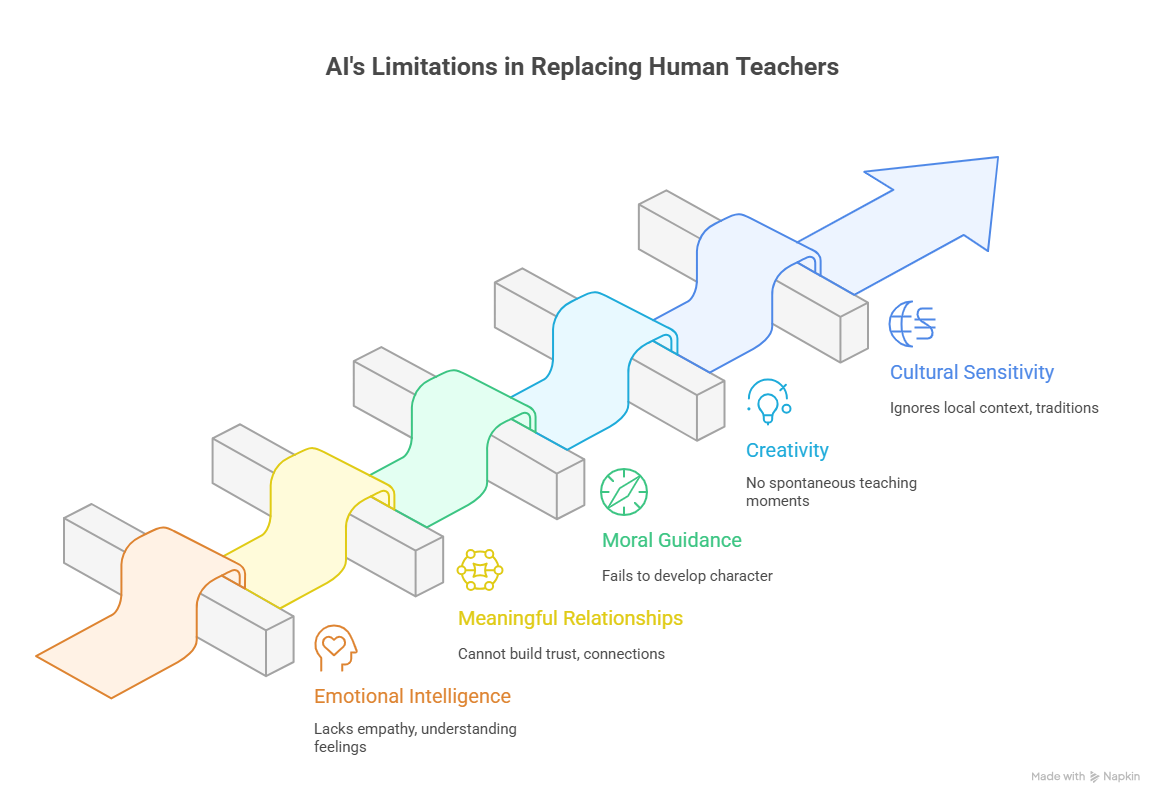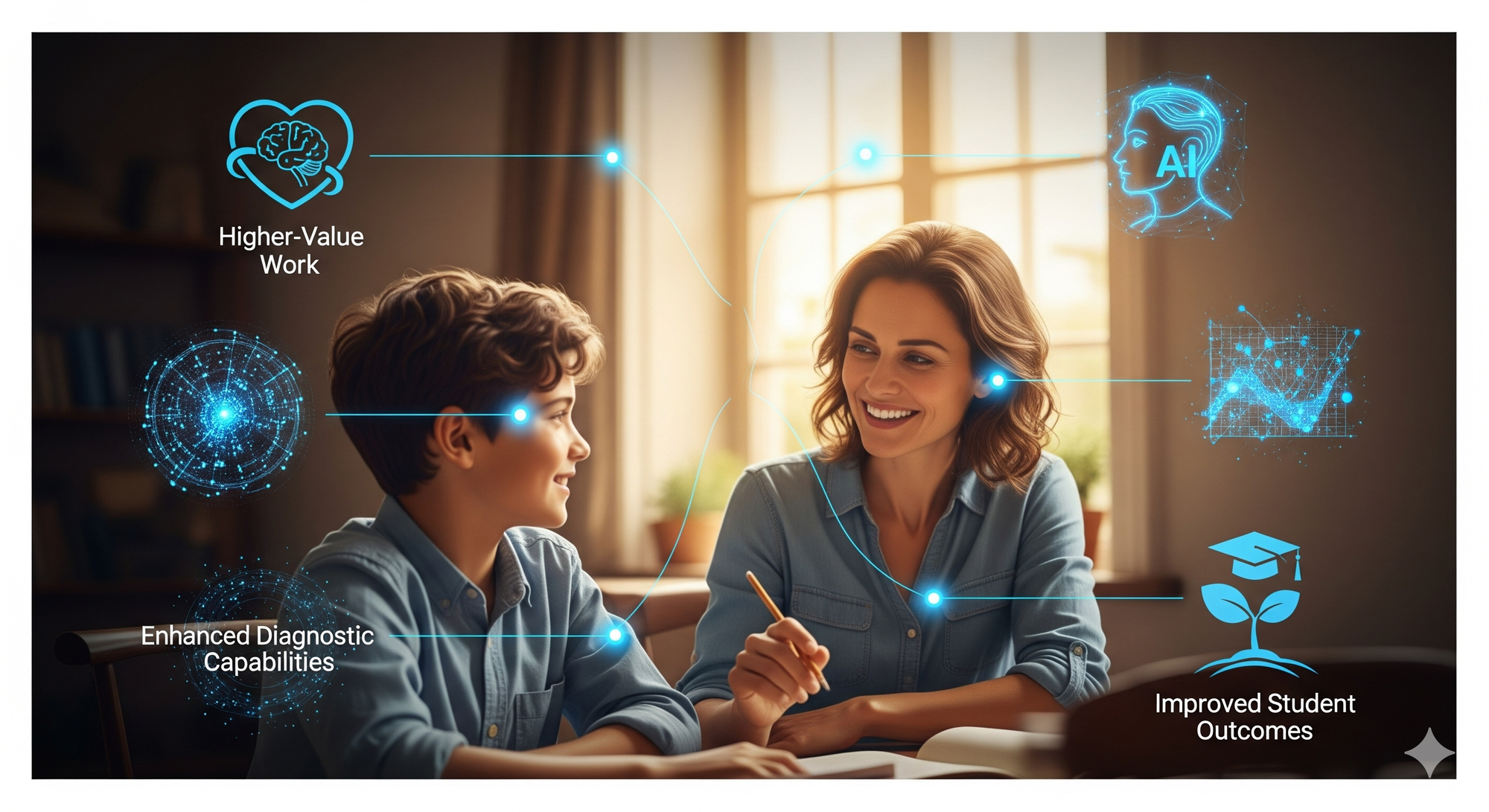
Teachers across America are asking the same tough question: Will AI replace teachers? It's a question that keeps educators up at night, sparks heated debates in faculty lounges, and dominates education conferences from coast to coast.
With artificial intelligence rapidly transforming every industry, it's natural to wonder about teacher job security and the future of teaching as we know it.
The fear is real, but so is the excitement. Some educators worry that AI will make their jobs obsolete, while others see incredible opportunities to enhance their teaching through technology.
The truth about whether AI can replace teachers lies somewhere in between these extremes, and it's far more nuanced than the headlines suggest.
This isn't just another "robots are coming" story. This is a balanced look at what AI actually can and cannot do in education, why the human element in education remains irreplaceable, and how the future of teaching with AI looks brighter than many teachers realize.
Let's explore what's really happening in classrooms today and what it means for educators tomorrow in this evolving landscape of AI vs human teachers.
The Current Reality: How AI is Already Changing Teaching
The question "can AI replace teachers in the classroom" isn't hypothetical anymore AI is already here, transforming education in ways both subtle and significant. According to recent data from EdWeek Research Center, about 51% of teachers are now using AI tools in some capacity, with adoption rates climbing every month. This represents a significant shift in AI in education trends 2025.
What's Actually Happening in Classrooms Today
Teachers are using AI for lesson planning, with platforms like ChatGPT and specialized education tools helping create engaging content in minutes rather than hours.
A middle school teacher in Ohio reports cutting her lesson prep time from 3 hours to 45 minutes using AI assistance. She's not alone – teachers nationwide are discovering that AI augments teachers, not replaces them in their daily work, demonstrating how educational technology and teachers work in partnership.
Grading and feedback have been changed by AI tools. High school English teachers are using AI-powered platforms to provide initial feedback on student essays, then adding their human insight and encouragement.
The result? Students get faster, more detailed feedback, and teachers save hours each week for actual teaching while maintaining those crucial student-teacher relationships.
Administrative tasks that used to consume evenings and weekends are now handled efficiently through AI. From generating parent communication templates to creating differentiated worksheets, AI teacher assistant tools are freeing educators to focus on what matters most.
Building relationships with students and addressing teacher job automation concerns through smart tool usage.
The Number Tells the Story
Recent surveys show that 60% of teachers use AI for routine tasks. These aren't tasks that require deep human connection or complex judgment – they're the administrative burden that's been weighing down the teaching profession for decades.
When we look at AI's impact on the teaching profession, the picture becomes clear: AI is eliminating the parts of teaching that teachers like least, not the parts they love most.
But here's what's important: in every successful implementation, human teachers remain at the center. They're not being replaced; they're being enhanced. The technology serves the teacher, not the other way around.
This teacher role transformation represents evolution, not replacement, addressing many concerns about AI replacing teachers while highlighting the irreplaceable qualities of human educators that are essential.
What AI Can Do: The Impressive Capabilities
To understand why AI cannot replace teachers, we first need to acknowledge what artificial intelligence does remarkably well in educational settings.

AI's capabilities in education are genuinely impressive and growing more sophisticated each month, yet they represent tools rather than replacements in the ongoing discussion of AI vs human teachers.
Personalized Learning at Scale
AI excels at creating personalized learning paths for individual students. Platforms like DreamBox for math or Reading Plus for literacy can analyse a student's learning patterns and adjust difficulty levels in real-time.
This level of individualization would be impossible for even the most dedicated human teacher managing 25-30 students simultaneously. This represents personalized learning with a human touch when teachers use AI insights to guide their interactions with students.
AI can identify learning gaps with precision that surpasses human observation in some contexts. By analyzing thousands of student responses, AI systems can pinpoint exactly where a student struggles with fractions or which reading comprehension strategies they haven't mastered, supporting the education automation potential in diagnostic assessment.
24/7 Availability and Instant Feedback
Unlike human teachers, AI never gets tired, never needs a break, and can provide support at 2 AM when a student is struggling with homework.
AI tutors in education can offer immediate explanations, generate additional practice problems, and provide hints without judgment or frustration.
This constant availability addresses a real gap in traditional education. How many times have students gotten stuck on a problem at home, with no way to get help until the next school day? AI fills that void effectively.
Administrative Excellence
AI handles routine administrative tasks with speed and accuracy that humans simply cannot match. Generating quiz questions, creating rubrics, drafting parent emails, and organizing lesson resources are tasks that, once consuming hours, can now be completed in minutes.
Data analysis represents another AI strength. AI can process student performance data across multiple assessments and identify patterns that inform teaching decisions.
Teachers receive actionable insights about class-wide trends and individual student needs without spending hours creating spreadsheets and charts.
Language and Accessibility Support
AI translation tools help teachers communicate with non-English speaking families instantly.
Text-to-speech and speech-to-text capabilities support students with different learning needs. AI can adjust reading levels, create visual aids, and provide multiple ways to access the same content.
These capabilities are genuinely transformative and explain why educational technology and teachers are increasingly working in partnership.
AI handles the scalable, data-driven, and routine aspects of education with impressive efficiency, demonstrating how technology enhances teaching rather than replacing it.
Fear to Future-Ready in 30 Days
Worried about AI taking over your classroom? Let's show you how to make AI work for you, not against you.

What AI Cannot Do: The Irreplaceable Human Elements
While AI's capabilities are impressive, understanding AI limitations in education reveals why the question "Will artificial intelligence replace teachers?" has a clear answer: no.
There are fundamental aspects of teaching that require distinctly human qualities that no algorithm can replicate, highlighting the teacher's irreplaceable qualities that define excellent education.

Emotional Intelligence and Empathy:
Teaching isn't just about delivering information, it's about understanding when a student is having a bad day, recognizing the look of confusion that means "I'm lost but too embarrassed to ask," and knowing how to motivate a discouraged learner.
Emotional intelligence in teaching involves reading micro-expressions, understanding cultural contexts, and responding to the emotional needs of individual students in ways that demonstrate human connection in education.
When a third-grader breaks down in tears during a math lesson, AI might suggest moving to an easier problem set. A human teacher recognizes that the tears aren't really about math.
They're about the argument with parents at breakfast, the fear of looking stupid in front of classmates, or the accumulated frustration of feeling behind. The human response addresses the whole child, not just the academic challenge.
Building Meaningful Relationships:
The teacher-student relationship forms the foundation of effective learning. Students don't just learn from teachers they like, they learn because they trust their teachers, feel seen and valued by them, and want to meet their expectations.
These student-teacher relationships develop through hundreds of small interactions, shared jokes, moments of encouragement, and gentle challenges that push students to grow.
AI might know that Maria struggles with reading, but a human teacher knows that Maria lights up when discussing her family's immigration story and can use that connection to engage her in literacy activities. These meaningful connections cannot be programmed or automated.
Moral Guidance and Character Development:
Teaching involves countless moments of moral instruction that happen naturally throughout the day. When students disagree, how do they resolve conflicts respectfully?
When someone makes a mistake, how do they take responsibility and make amends? When facing a difficult choice, how do they consider the impact on others?
Human teachers model ethical behaviour, facilitate discussions about complex moral issues, and help students develop their own moral compass.
This character development happens through example, discussion, and the countless small decisions that teachers help students navigate throughout their school years.
Creativity and Spontaneous Teaching Moments:
The best learning often happens when teachers abandon their planned lesson to follow a student's unexpected question, when they connect a current event to the curriculum in a moment of inspiration, or when they recognize that the class needs a completely different approach than what was planned.
AI follows algorithms and data patterns. Human teachers read the room, pivot when needed, and create magical learning moments that no lesson plan could have predicted.
When a butterfly lands on the classroom window during a science lesson, AI might stick to the scheduled content about plant life cycles.
A human teacher recognizes the perfect teachable moment and transforms the entire class period into an impromptu exploration of insect metamorphosis.
Cultural Sensitivity and Local Context:
Every classroom exists within a specific community with unique cultural dynamics, local traditions, and shared experiences. Human teachers understand these contexts intuitively and weave them into their teaching naturally.
AI might know the demographics of a school district, but human teachers understand that this week's football game matters to their students, that the local factory closure is affecting families, or that the community's agricultural heritage can be leveraged to make science concepts more relevant and engaging.
Why Teachers Are "Wisdom Workers," Not Just "Knowledge Workers"
The distinction between knowledge work and wisdom work helps explain why AI cannot replace teachers and why the future of teaching remains bright. This concept, championed by education leaders worldwide, reframes our understanding of what teachers actually do.

Understanding teachers as wisdom workers, not knowledge workers, provides crucial insight into the ongoing debate about whether AI can replace teachers.
Knowledge vs. Wisdom: A Critical Distinction
Knowledge workers process information, analyze data, and produce content based on existing information. AI excels at these tasks.
Wisdom workers, however, do something fundamentally different: they help others develop judgment, apply knowledge ethically, and navigate complex human situations where there are no clear right answers.
Teachers don't just deliver curriculum content, they help students develop critical thinking skills, evaluate sources, consider multiple perspectives, and make reasoned decisions.
When high school students study historical events, AI can provide facts, dates, and analysis. Human teachers help students understand how those historical lessons apply to current events and their own lives.
Ethics and Moral Reasoning
Every day, teachers help students navigate ethical questions that don't have simple answers. Should you tell the teacher if you see a classmate cheating? How do you balance being honest with being kind? What are your responsibilities to your community and to future generations?
These conversations happen naturally in classrooms through literature discussions, science ethics, historical analysis, and everyday situations.
Teachers guide students in developing their own moral reasoning abilities not by providing answers, but by asking the right questions and creating safe spaces for exploration.
Developing Human Judgment
Perhaps most importantly, teachers help students develop judgment, the ability to make good decisions in complex, ambiguous situations. This involves understanding context, considering consequences, weighing competing values, and taking action despite uncertainty.
AI operates on algorithms and patterns. Human wisdom involves knowing when to break the rules, when exceptions make sense, and how to balance competing priorities.
These are the skills students will need most in an AI-enhanced world where human judgment becomes increasingly valuable.
Teachers + AI = Teaching Superpowers
Join the 60% of teachers already using AI to cut prep time and boost student outcomes. Your transformation starts with one call.

The Future Partnership: AI Augmenting, Not Replacing Teachers
The real answer to "can robots replace teachers" becomes clear when we examine successful AI implementation in schools: the future belongs to human teachers who know how to leverage AI tools effectively.

This partnership model represents the future of teaching with AI, where technology enhances teaching rather than replacing it, creating a powerful AI education partnership that benefits everyone.
AI Frees Teachers for Higher-Value Work
When AI handles routine tasks like generating quiz questions, checking basic assignments, and organizing resources, teachers gain time for activities that require human expertise.
Instead of spending hours creating worksheets, teachers can focus on designing engaging learning experiences, providing individualized support, and building relationships with students.
Enhanced Diagnostic Capabilities
AI provides teachers with insights about student learning that would be impossible to gather manually. By analyzing patterns in student responses, AI can alert teachers to misconceptions, identify students who need additional support, and suggest interventions before problems become serious.
However, human teachers interpret this data within the context of each student's life circumstances, learning style, and emotional needs. The AI might identify that Jamie is struggling with fraction concepts, but the teacher knows that Jamie learns best through hands-on activities and has been distracted lately due to family challenges.
Personalization with Human Connection
AI excels at delivering personalized content, but human teachers provide personalized relationships. Students might receive individualized math problems from an AI system, but they need human encouragement, celebration of progress, and support through challenges.
The most effective classrooms combine AI's ability to customize learning paths with teachers' ability to motivate, inspire, and connect with students personally. Technology provides the scaffolding; teachers provide the heart.
Improved Student Outcomes
Early research on AI-teacher collaboration shows promising results for student achievement. When teachers use AI tools effectively, students receive more personalized instruction, faster feedback, and additional practice opportunities. Meanwhile, teachers can provide more individual attention, emotional support, and higher-order thinking experiences.
The key insight is that AI education partnership works best when teachers remain firmly in control, using AI as a powerful tool to enhance their existing expertise rather than replace their judgment.
Addressing Teacher Concerns About Job Security
Teacher job automation concerns are understandable given the rapid pace of technological change across industries. However, employment data and expert analysis provide reassuring evidence about the future of the teaching profession, particularly when considering teacher job security in the context of AI integration.
What the Employment Data Shows
According to the Statistics, employment of elementary, middle, and high school teachers is projected to grow 4-8% from 2021 to 2031, about as fast as the average for all occupations. This growth is driven by increasing student enrollment and ongoing teacher shortages, not by AI replacement concerns.
More tellingly, states and districts investing heavily in educational technology are typically hiring more teachers, not fewer. These schools need educators who can work effectively with new tools, mentor students through technology integration, and provide the human connection that makes learning meaningful.
Skills That Become More Valuable
As AI handles routine tasks, certain human skills become increasingly valuable in education. Teachers who excel at building relationships, facilitating discussions, providing emotional support, and developing critical thinking skills find themselves more essential than ever in the AI vs human teachers landscape.
The teaching profession's evolution emphasizes skills that AI cannot replicate: creativity, empathy, cultural competence, moral reasoning, and the ability to inspire and motivate others.
These skills have always been important in teaching; AI simply makes them more clearly indispensable, demonstrating teachers' irreplaceable qualities that define effective education.
Professional Development Opportunities
Teachers who embrace AI tools often find new professional development opportunities opening up. They become teacher leaders, helping colleagues integrate technology effectively.
They contribute to curriculum development, designing learning experiences that combine AI capabilities with human pedagogy.
Many teachers discover that learning to work with AI enhances their understanding of how students learn, making them more effective educators overall.
The process of learning to prompt AI effectively often improves teachers' ability to ask good questions and design clear learning objectives.
Adaptation Strategies That Work
Successful teacher adaptation to AI involves three key strategies:
Start Small: Begin with AI tools that solve immediate problems, like generating discussion questions or creating differentiated materials. Build confidence with simple applications before moving to more complex integrations.
Focus on Pedagogy: Use AI to handle logistics and preparation, freeing up time and energy for the teaching activities you love most. Let technology enhance your natural teaching strengths rather than trying to change your fundamental approach.
Collaborate and Learn: Work with colleagues who are successfully using AI tools. Share experiences, troubleshoot problems together, and learn from each other's successes and challenges.
The teachers thriving in AI-enhanced environments aren't necessarily the most tech-savvy they're the ones who remain focused on student relationships and learning outcomes while using AI strategically to support those goals.
Preparing for the AI-Enhanced Classroom
The question isn't whether AI will impact education it already has. The important question is how teachers can prepare for the AI-enhanced classroom while maintaining human-centered education approaches that serve students best.
This preparation is essential for understanding the future of teaching and ensuring that AI will replace teachers remains a resounding "no" as educators adapt and thrive.
Essential Skills for Teachers to Develop
AI Literacy: Teachers don't need to become programmers, but they should understand how AI tools work, their capabilities and limitations, and how to use them effectively. This includes learning to write effective prompts, evaluate AI-generated content, and troubleshoot common problems.
Digital Pedagogy: Knowing how to integrate AI tools seamlessly into lesson plans requires understanding how technology can enhance learning objectives without becoming a distraction. This involves designing activities that combine AI capabilities with human interaction meaningfully.
Data Interpretation: AI generates lots of data about student learning. Teachers need skills to interpret this information, identify actionable insights, and make instructional decisions based on evidence while considering the whole child.
How to Work Effectively with AI Tools
Start with Clear Learning Objectives: The most effective AI integration happens when teachers begin with clear goals for student learning, then select AI tools that support those objectives. Technology should serve pedagogy, not drive it.
Maintain the Human Connection: Use AI to handle routine tasks so you can spend more time building relationships with students, facilitating discussions, and providing individualized support. Let AI do what it does well so you can focus on what humans do best.
Test and Iterate: Try AI tools with low-stakes activities first. Experiment with different approaches, gather student feedback, and refine your methods based on what works in your specific context with your particular students.
Collaborate with Colleagues: Share experiences with other teachers, learn from their successes and challenges, and work together to develop best practices. The learning curve is easier when you're not climbing it alone.
Stop Teaching Scared, Start Teaching Smart
While others worry about AI replacing teachers, you could be leading the AI revolution in education. Ready to get ahead?

Conclusion
So, can AI replace teachers? The answer is both simpler and more complex than the question suggests. AI cannot and will not replace the essential human elements that make teaching effective: the relationships, empathy, moral guidance, and wisdom that come from human experience.
However, AI can and already is transforming how teachers work. It's eliminating the routine tasks that have burdened educators for decades, providing new insights into student learning, and creating opportunities for more personalized and engaging education.
The future belongs to educators who understand that AI vs human teachers isn't a competition. It's a collaboration that can revolutionize learning while keeping human connection at its heart.
Ready to Transform Your Educational Institution with AI?
If you're an educational leader looking to implement AI thoughtfully while keeping human connection at the center, we can help. Our team specializes in developing AI strategies that enhance teaching effectiveness without sacrificing the relationships that make learning meaningful.
Contact us today to discuss how your school or district can harness the power of AI. Let's build the future of education together. One that values both technological innovation and human wisdom.
FAQs
Will AI replace teachers and make my job obsolete?
No, AI cannot replace teachers. While AI excels at handling administrative tasks and providing personalized learning tools, it lacks the emotional intelligence, empathy, and human connection that make teaching effective. Teachers are wisdom workers, not just knowledge workers, providing moral guidance and building meaningful relationships that AI simply cannot replicate.
How is AI already being used in classrooms today?
Currently, 51% of teachers use AI for lesson planning, grading, and administrative tasks like generating worksheets and parent communications. AI helps teachers save 5-10 hours weekly by automating routine work, allowing more time for student relationships and personalized instruction. The technology serves as a powerful teacher assistant rather than a replacement.
What teaching skills will become more valuable with AI integration?
Human skills like creativity, emotional intelligence, critical thinking facilitation, and cultural sensitivity become increasingly valuable. Teachers who excel at building student relationships, inspiring learning, providing moral guidance, and adapting to unexpected classroom moments will find themselves more essential than ever in an AI-enhanced educational environment..
Should I be worried about teacher job security with advancing AI technology?
Teacher job security remains strong, with employment projected to grow 4-8% through 2031. Schools investing in educational technology typically hire more teachers, not fewer. The key is adapting to use AI tools effectively while focusing on the irreplaceable human elements of teaching that students need most.
How can teachers prepare for working with AI in education?
Start by developing AI literacy - understanding how AI tools work and their limitations. Begin with simple applications like lesson planning or generating discussion questions. Focus on maintaining the human connection while using AI to handle routine tasks, and collaborate with colleagues to share best practices and learn together.
What's the biggest benefit of AI for teachers and students?
AI frees teachers from time-consuming administrative burdens, allowing them to focus on what matters most: building relationships, providing individualized support, and creating engaging learning experiences. Students benefit from immediate feedback, personalized learning paths, and 24/7 support, while still receiving the emotional guidance and inspiration only human teachers can provide.

